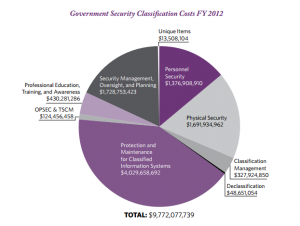The cost of classifying government documents is going down, but so is both the number of classified documents and the number of individuals doing the work. The cost of classification for both government and industry in 2012 was $10.96 billion, according to a recently released report by the Information Security Oversight Office. That number is down 13 percent from the year prior.
The estimated cost of security and classification for industry is $1.19 billion. For government the cost was $9.77 billion.
The total number of classification authorities, or individuals with the authority to classify information, is 2,326. The number is down nearly half from five years ago.
The cost of classifying information is based on estimations provided by 42 government agencies. Industry costs were based on information collected by the Defense Security Service and provided to ISOO. The report breaks down cost estimations into a variety of areas, including Protection and Maintenance for Classified Information Systems, Security Management, Personnel Security, Physical Security, Training, and others.
Classified information systems make up the bulk of expense, with more than $4 billion in cost to government and industry. Physical security falls next at $1.6 billion. In the wake of a major leak by a government contractor, it’s worth noting that professional education, training and awareness cost $430 million. Agency heads and industry security managers alike are likely to begin exploring training and awareness procedures in 2013, with the aim of preventing the next leak before it happens.
In 2012 44.92 million pages were reviewed, and 44 percent of those pages were declassified. This is a seven percent reduction from 2011, when 52.76 million pages were reviewed and 51 percent were declassified. According to the report, reductions in the number of pages reviewed is a result of automatic declassification reviews.
Not surprisingly, the Department of Defense produces the greatest number of documents for automatic declassification, with the CIA, Army, State Department, Navy, and Department of Energy rounding out the list of those with more than 500,000 pages.
Types of declassification
Automatic: Removes the classification of information at the close of every calendar year when information reaches the 25-year threshold.
Systematic: Review is required for those records exempted from automatic declassification.
Discretionary: Provides direct, specific review for declassification of information when requested by the public.





